The first step in organizing a water treatment system in a cottage or cottage community is to determine the total water flow, and, consequently, the maximum performance and filter size. Then, based on the data obtained, filtration equipment is selected taking into account the results of laboratory tests.
The amount of water consumed is an indicator that directly depends on the quality of life. According to historical records, one Muscovite in 1890 consumed 11 liters of water daily. After 20 years, a resident of the capital already needed 66 liters. By 1959, consumption rates exceeded half a cubic meter. Today, one resident of a metropolis needs about 700 (!) liters of water per day. Perhaps the figure is erroneously inflated?
What does water consumption depend on?
Water consumption depends on the climate and the nature of the work performed. According to medical data, 1-2 liters are excreted only through human sweat. liquids. Consequently, in regions with warm climates, the required amount of water is significantly higher.
The consumption of cold and hot water. The average Russian family with two minor children needs 7,000 liters of hot water and 10,000 liters. cold water.
Video: a way to save up to 75% water and pay less! Let's watch the story!
Daily water consumption standards
On the territory Russian Federation Water consumption standards are determined by SNiP.
According to reference data, in modern homes water is consumed not only to quench thirst, but also for washing, cooking and hygiene procedures (Table 1).
|
Type of water source |
Daily water consumption |
|
Preparing drinks |
1.5-2 liters |
|
Cooking |
|
|
Washing hands without turning off the tap |
6-8 liters |
|
Brushing your teeth without turning off the tap |
6-7 liters |
|
Rinsing the toilet (in one flush) |
10-15 liters |
|
15-20 liters per minute (150-200 liters in 10 minutes) |
|
|
150 liters |
|
|
50-100 liters |
|
|
Dishwasher |
7-10 liters per cycle |
|
300-570 liters |
If we take into account the regular self-washing of vehicles (bicycles, cars), watering flowers and garden plots and changing the water in the pool, it is not surprising that the average consumption is still seriously inferior to the amount of clean water required for one person. A child under 14 years of age uses approximately half as much water as an adult.
Water consumption standards vary in different countries. For example, the average American uses 400-650 liters of water daily, while an entire African family is content with only 20 liters.
Water consumption in numbers
As can be seen from the calculations, real water consumption has long exceeded the calculated standards. That is why residents of cottages and private houses are increasingly saving on water treatment systems through the use of high-performance collective filters designed for dozens and even hundreds of water consumption sources.
Have you turned on the irrigation system on your lawn, but the water has stopped flowing from the faucet in your house? - The water supply scheme for the house was clearly calculated incorrectly. How should water consumption be calculated?
- 1 of 1
In the photo:
The amount of water consumed by one person differs significantly from the needs of a large family.
Calculating water supply is simple if you know the number of people permanently residing in the house, the exact number of proposed water points and their purpose, the presence of irrigation systems in personal plot. Do not forget also about the “debit” (potential capacity) of a water source - a well, a borehole.
How many people?
Water supply calculation is, in fact, the total water consumption per day. Contrary to the existing misconception, water consumption is calculated not “by bathrooms,” but by average data per person (after all, it is not the bathroom that consumes water, but the people who use it). Consider not only the number of permanent residents, but also the maintenance staff (even visiting ones). Consider how often guests will stay with you.
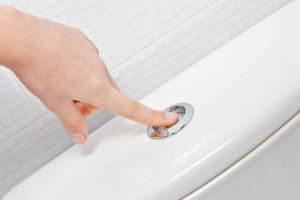
- 1 of 1
In the photo:
Using a shower is much more economical than taking a full bath.
Toilet in reserve If you are concerned about saving money, then it is better to refrain from including “future expenses” in the water supply calculation project. For example, additional bathrooms planned for the distant future or the installation of a bidet. Especially if you are not sure that you will equip them at all.
In the photo: toilet 821971 from the Laufen factory, designed by Giovannoni Stefano.
Number of water points
This concept includes absolutely all devices connected to the water supply. These include bathtubs, showers, washbasins, washing and dishwashers, toilets and bidets. In addition, the calculation of water consumption takes into account all equipment for washing cars, pipes for irrigation systems, fountains, etc.
When compiling a list for water supply calculations, remember: the more water points included in the project, the more powerful and expensive equipment will be required to organize the water supply. And pipes will need a larger diameter, which will complicate installation, and as a result, the final cost of the work will increase.
Drawing point designation
It is quite obvious that the toilet will require much less water than, for example, the water intake point in the bathroom (see table).
Water consumption per procedure (in liters) |
||
| type of consumption | total amount of water | amount of hot water (at a temperature of 60°C) |
| Taking a bath | 150-180 | 70-85 |
| Using the shower | 30-50 | 13-22 |
| Hand washing | 3-5 | 1,3-2,5 |
| Flushing the toilet | 12-15 | — |
| Using a bidet | 15-17 | 7-8 |
| washing dishes for a family of 2 people |
15-16 | 12-13 |
| for a family of 3 people | 20-22 | 17-20 |
| for a family of 4 | 24-26 | 21-24 |
Irrigation system
on a personal plot can consume different amounts of water - it is difficult to predict. Calculation of water supply largely depends on the area of planting, seasonality, frequency of precipitation, etc.

- 1 of 1
In the photo:
To water the plants, you can use water, for example, from a drainage well or storm sewer. And then the presence of an irrigation system will not affect total consumption clean water.
Water Source Possibilities
are the only factor that is in no way under the control of either the home owner or the utility designer. If the flow rate of a well or well is low, then the total daily water consumption in the house will depend on it. After all, residents will be able to use only the amount that the source can provide. It makes no sense to install a more powerful system and focus on the “desired” water supply calculation: you will have to come to terms with it and learn to save water.
This article uses images from paduiblog.com, migrelief.wordpress.com, udachnyi.com
Comment on FB Comment on VK
Also in this section
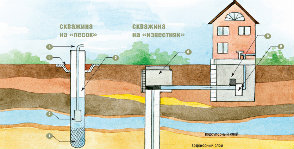
A well is a convenient and compact source of water for autonomous system water supply However, this method of water extraction also has its disadvantages. We study the main types of wells and tell you which one to choose.
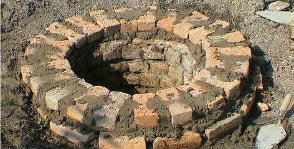
Even a shallow well, drilled without the help of specialists, must be properly equipped - otherwise it simply will not produce water. We make the casing and head, lay the pipeline.

It will not be possible to drill an artesian well without the help of specialists, but you will have to buy equipment for its construction yourself. So, what does it take for a well to work properly?
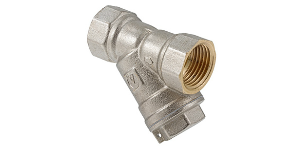
Mechanical cleaning filters are the most important part of any home water supply system. They retain sludge - coarse particles of dirt and sand, purifying the water and ensuring the safety of equipment.
Consumption of water resources is one of the most expensive items of utility expenditure for city residents. Consumption values can easily depend on the region in which the service is provided, since tariffs are different and other nuances occur. Standards and regulations are not set by utilities or management companies. Each locality has its own standards, divided into hot and cold water consumption rates.
Calculations are carried out using the relevant standards, which are approved by the committees and commissions in the sphere of housing and communal services of each constituent entity of the Russian Federation. This suggests that there are no uniform indicators in Russia when calculating water resource consumption.
The amounts of water consumption are also variable. They change depending on the seasons, seasonal needs, the individual needs of each person and other characteristics. That is why unevenness coefficients are used in calculations. Here we take into account the number of registered residents and SNiP standards ( sanitary standards and rules).
Save your time and nerves. and within 5 minutes you will receive free consultation professional lawyer.
Approved consumption indicators
The list of generally accepted standards identifies the main indicators that are used in most settlements:

This list does not take into account household expenses, which are not available in all families. For example, there are no standards for washing motor vehicle, changing water in an aquarium, swimming pool, watering the local area. For such purposes, hourly irregularity coefficients are used, taking into account the presence of a sewer system. The water used for heating the living space is also taken into account.
Applicable coefficients
If there is an internal water supply and sewerage system, hot water supply, the coefficients range from 1.25 to 1.15 k/hour. Under the same conditions, in the presence of a bathtub and a gas water heater, the coefficient values are from 1.2 to 1.15 k/hour. The situation is somewhat different with the presence of a bathroom and wood-burning heaters - from 1.4 to 1.2 k/hour. With the presence of internal water supply, but without a bathroom, indicators from 1.6 to 1.4 k/hour are used.
![]() Water consumption standards necessarily include cost items for fire extinguishing. However, since such needs are classified as periodic, the principles of calculation are based on the localization of the fire point and the supply of resources to influence it. Here in mandatory The specifics of the premises must be taken into account.
Water consumption standards necessarily include cost items for fire extinguishing. However, since such needs are classified as periodic, the principles of calculation are based on the localization of the fire point and the supply of resources to influence it. Here in mandatory The specifics of the premises must be taken into account.
Another indicator of standard water volume consumption is the location of a shower or bathtub in the room. Residential houses, which have a built-in water supply and sewerage system, but are not equipped with a bathroom, are designed to consume from ninety-five to one hundred and twenty liters of water per day. This is an indicator of water use per person. If a similar house has a bathroom, as well as devices for heating the water resource, the norms increase to one hundred and eighty liters per day.
Nuances with water heating and savings
If the room is equipped with a gas water heater, then in similar situations the standards for hot water consumption range from one hundred and ninety to two hundred and twenty-five liters per day per resident. When heating of a water resource is carried out due to operating on solid fuel structures, consumable items are smaller and range from one hundred and fifty to one hundred and eighty liters per day. Installing a shower in a residential area, on the contrary, increases consumption from two hundred thirty to two hundred seventy liters. Similar indicators are taken into account in the presence of an additional washbasin.
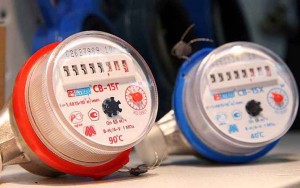 Most of the living citizens who have installed resource consumption metering devices in their living space have the opportunity to thus save on paying for the services provided to them. public services. However, residents are required to install such devices at their own expense, including the purchase of equipment. The cost of installation will depend on how many meters a person installs. In general, if only one riser passes through the living space, two metering devices are enough - for hot and cold water.
Most of the living citizens who have installed resource consumption metering devices in their living space have the opportunity to thus save on paying for the services provided to them. public services. However, residents are required to install such devices at their own expense, including the purchase of equipment. The cost of installation will depend on how many meters a person installs. In general, if only one riser passes through the living space, two metering devices are enough - for hot and cold water.
Actual consumption
It should not be assumed that the installation of meters necessarily entails the need to reduce the usual water consumption. In fact, people are required to control their own consumption of the resource and not pour water in vain. In any case, this is not a typical situation - to spend a resource beyond the norm, even if a person does laundry, wet cleaning and bathing every day. In practice, after installing hot and cold water meters, payments are reduced by two or even three times. Of course, if you do not take into account those cases when one person is registered in a living space, but in fact four live. In such cases, without meters, payments will be less than with them.
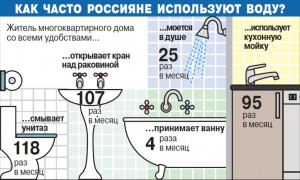 Another advantage of meters is that a person pays only for what he actually consumed. If he went on vacation or a long business trip and no one used the water in his house during this period, he will not pay for it. If there are no meters, whether someone was at home or absent for three months, you will have to pay according to tariffs.
Another advantage of meters is that a person pays only for what he actually consumed. If he went on vacation or a long business trip and no one used the water in his house during this period, he will not pay for it. If there are no meters, whether someone was at home or absent for three months, you will have to pay according to tariffs.
By comparing water consumption rates per person per month with actual consumption, monthly expenses for all expense items are calculated.
Taking this data into account, the following monthly averages apply throughout the country:
- Visiting the toilet – 118 times (in dormitories 123 times);
- Washing in the bathroom – 4 times;
- Taking a shower – 25 times (in dormitories 17 times);
- Use of the sink – 107 times;
- Use kitchen sink– 95 times.
Additional consumption indicators
Based on the above, we can also mention that, according to statistics, water is used thirty-one times per month for cleaning homes and the same amount for washing clothes. Certain regions of the Russian Federation have more specific data regarding the consumption of cold and hot water.
 Consumer water consumption standards for sanitary needs according to some utility services:
Consumer water consumption standards for sanitary needs according to some utility services:
- Taking a shower - up to one hundred liters;
- Bathing in the bathroom - about two hundred to three hundred liters;
- One-time visit to the toilet – up to six liters.
It is also necessary to take into account that even when the bathroom is used frequently, with its capacity of two hundred and fifty liters and everyday washing, there are water consumption rates that are inflated - increasing coefficients. Of course, no government agencies can control the amount of resource used in each individual apartment, therefore, in order to avoid unwanted overpayments, the most correct solution is to install meters.
In addition, if we consider the capital regions, then per person per month there is 3.81 cubic meters. hot in water and 5.48 cu. cold water. If there are no meters, the owners are obliged to pay the tariffs established in the region, regardless of how much they actually consumed.
How to calculate the consumed resource
 Since each individual apartment is equipped with sanitary equipment, private house and other residential construction sites where it is impossible to do without the consumption of cold water, it is impossible to control the actual amount of consumed resources without meters. Therefore, average standards are applied, taking into account the total amount of water used in the locality with the assumption that half of the residential properties have meters.
Since each individual apartment is equipped with sanitary equipment, private house and other residential construction sites where it is impossible to do without the consumption of cold water, it is impossible to control the actual amount of consumed resources without meters. Therefore, average standards are applied, taking into account the total amount of water used in the locality with the assumption that half of the residential properties have meters.
The information obtained in this way is summarized, after which the share that falls on the living space with metering devices is determined. By subtracting this share, we get the volume of resource that is consumed by all residents who do not have installed meters. The result is divided by the total number of unequipped apartments. According to statistics, the share of users without meters automatically accounts for two-thirds of the total consumption in the locality. Thus, standard standards for hot and cold water consumption per person are approved.
Established standards contribute to the transition to new forms of accounting for water resource consumption and increase the efficiency of its use. At the same time, it should be borne in mind that for users who have not yet installed hot and cold water meters, prices for the introduced consumption standards will increase over time.
The information in this article is provided for informational purposes only.
We recommend that you contact our lawyer.
A person cannot live without water for long. If you can live without food for 21 days, then without water - only 7. This is due to the fact that in the human body 70% of water, which consists of organs, tissues, blood and lymph, through which they are transported to all systems and organs. nutrients, oxygen, cell waste products and toxins are removed. Since the body gradually loses fluid, it must be replenished, otherwise the lack of water leads to disruption of the functioning of all organs and systems, and well-being, memory, and attention deteriorate. A loss of 10-15% of water is fatal. Therefore, all medical sources write that the norm for a person’s water consumption per day, depending on age, weight, weather conditions and the amount of physical activity, is from 1 to 5 liters.
What are the norms for daily drinking water consumption for humans?
There are officially accepted standards for how much water a person should drink per day. So, on average, from the body of an adult of average build (70 kg) with moderate physical activity About 2.5 liters of water are excreted (breathing, sweat, kidney function, intestines), so to replenish the balance you need to consume 2.5 liters of water. This volume is accepted as the norm.
For a more accurate calculation - 40 g of water (0.04 l) per 1 kg of body weight. It should be taken into account that water is contained in all products - fish 68-70%, meat - 58-62%, bread - up to 50%, cereals - about 80%, fruits and vegetables - 90%, that is, in " dry food – 55-60% water. If we take the 2.5 liter rate as a basis and solve the equation, it turns out that in pure form You need to drink 1.2-1.5 liters of water per day.
Is it good to drink more water than normal?
You should drink more than normal during intense physical activity and high temperature. environment(for diseases with high fever, women during feeding, etc.), then another 20% is added to the norm. If such factors are absent, excessive water consumption has a negative effect - the load on the kidneys increases, salts and minerals are removed from the body, muscle fatigue increases, and sometimes cramps may occur.
28.10.2016